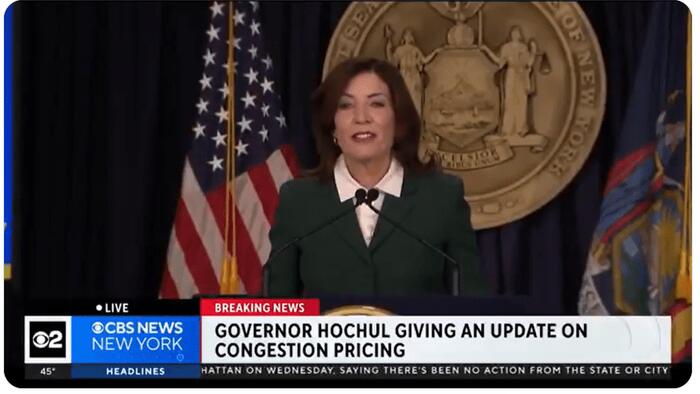In a recent statement from New York Governor Kathy Hochul, she highlighted a notable reduction in a proposed congestion tax for entering Manhattan, presenting it as a victory for New Yorkers. The original idea was to implement a $15 charge on commuters, which many saw as burdensome given the ongoing economic pressures faced by families in the state. Hochul claimed that her administration has listened to the concerns of the public, and she has now reduced this charge to $9, framed as a 40 percent decrease. Hochul emphasized that this change would significantly benefit daily commuters, potentially saving them nearly $1,500 annually. However, this proposed tax and its subsequent reduction have sparked criticisms and concerns regarding the larger implications of such financial policies.
The governor characterized the decision to reduce the congestion tax as a crucial measure aimed at improving affordability for New Yorkers, particularly amidst rising costs of living, including groceries, rent, and childcare. She positioned herself as an advocate for working families, pausing the initial tax plan and asserting it would lead to a different, more equitable approach to congestion pricing. Nevertheless, critics have challenged the notion that lowering the toll represents a genuine solution to the financial struggles many New Yorkers face, suggesting that the overall tax structure continues to burden families rather than alleviating their financial woes.
The irony of Hochul’s announcement lies in the extreme measures it employed to frame the tax reduction positively. Critics have pointed out that the reduction from $15 to $9 still implies a hefty fee for commuters, effectively normalizing a significant tax burden under the guise of a “savings.” The calculated marketing of this policy, which appears to celebrate a reduction framed as a great achievement, has been likened to Orwellian doublespeak, where the manipulation of language obscures the harsh realities of taxation and its impact on everyday lives. This situation raises concerns about the transparency and ethics behind such public policies and the narratives crafted around them.
Moreover, skeptics of the governor’s rhetoric have highlighted the mathematical manipulation involved in how the savings are presented. The claim that New Yorkers would save $1,500 annually by paying a lower toll fails to account for the initial tax burden that had been considered, raising questions about the sincerity of the savings claim. Critics suggest that treating a reduction from an overly high tax as a monumental achievement dilutes the genuine concerns of residents who grapple with the actual cost of living in New York City. The decision-making process, framed as responsive to the needs of constituents, appears instead to create a façade of benevolence while leeching additional funds from the very families it is supposed to serve.
Many observers are baffled by the political landscape that allows such policies and messaging to prevail, questioning how measures perceived as anti-consumer can continue to be supported by the electorate. This phenomenon could highlight a broader disconnect between political leaders and the constituents they claim to represent. The perceived normalization of substantial taxation as both a necessity and a solution contradicts the principles of fiscal responsibility, particularly when the outcomes don’t align with the proclamations made by those in power. The situation underscores the complexities within the governance of urban environments, where policymakers often walk a tightrope between funding essential services and ensuring the affordability of living within these economic ecosystems.
As New Yorkers reflect on Hochul’s intentions and policies, they are forced to consider the broader implications of such taxation strategies. The governor’s efforts to address congestion and improve public infrastructure must be matched by an honest assessment of the impacts these strategies have on everyday lives. The discussion around the recent proposals also serves as a reminder of the need for greater accountability in the decision-making processes affecting the public. Ultimately, the framing of tax policies as beneficial when they may not be in reality reflects a significant challenge to governance, placing the spotlight on the need for clear communication, genuine representation, and a commitment to truly supporting the residents of New York City.

